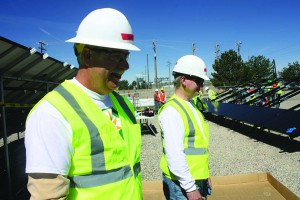Low-Income Electric Co-op Members Get Solar Energy
By Kent Singer, CREA Executive Director
Can I let you in on a secret? I have a great job. After the legislative session comes to an end, I have a chance to travel around our spectacular state to attend co-op annual member meetings, board of director meetings and other co-op functions. With all the rain and snow that we were blessed with this spring, the mountains and plains are as beautiful as I have ever seen them in the 31 years I lived in Colorado.
But even more impressive than the scenery is all the brilliant work being done by the boards and staff members of Colorado’s electric co-ops. I am continually amazed by the innovation and ingenuity of electric co-ops in their efforts to find new and better ways to serve their member-owners.

GVP General Manager Tom Walch (left) and CREA Executive Director Kent Singer (right) help bring the community solar garden to life.
One example of this ingenuity is the adoption of new business models for the integration of solar power into electric co-op power supply portfolios. There are many ways for consumers to access solar power, from the installation of solar panels on their rooftops to participation in community solar farms to the integration of utility-scale solar arrays into the overall power supply mix.
What has been missing from the solar “status quo,” however, is a way to broaden access to solar so it includes co-op member-owners who can’t afford a solar panel array. Recently, one of our member co-ops, Grand Valley Power in Grand Junction, found a way to bring the benefits of solar energy to a group of its member-owners that were previously priced out of solar. Working with a nonprofit called GRID Alternatives, Grand Valley Power installed a 29-kilowatt community solar garden that is dedicated to reducing the electric bills of those who are in most need of the assistance. At the Grand Valley “Solarthon” (kind of like an old-fashioned barn raising), teams of volunteers donned hard hats and safety vests to help install solar panels at the Grand Valley Power community solar array along Interstate 70 in Grand Junction.
At the end of the day, GVP General Manager Tom Walch flipped the switch to energize the substation that will deliver carbon-free kilowatt-hours from the solar panels to member-owners of the electric co-op that provides service in Mesa, Delta and Garfield counties.
This project, the first community solar garden in Colorado targeted at assisting low-income electric co-op member-owners, will offset the power usage of eight families in the Grand Valley Power service area. These families will continue to pay a monthly facilities charge, but they will see a significant reduction in their monthly electric bills since their energy usage will be offset by the electricity generated by the solar panels. After a four-year subscription period for the initial signees, a new set of co-op consumers will get their chance to save with solar.
Volunteers came from throughout Colorado and from as far away as Texas and California to be a part of the Grand Valley Power Solarthon. We were assigned to teams, and I got to work with volunteers from the National Renewable Energy Laboratory and others to install the solar panels that will be producing energy at this site for the next couple of decades. With the expert assistance of the project management team assembled by GRID Alternatives, even a neophyte like me could assist with the installation of the solar panels.
The Grand Valley Power community solar project exemplifies electric co-ops’ seventh principle, concern for community. Kudos to the GVP board and staff for their imagination and ingenuity in responding to the needs of their co-op member-owners.

